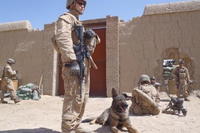A new, flexible hood a little more than an inch thick is expected to better protect military working dogs at risk for short-term or permanent hearing loss on the job, the Army Research Office announced Wednesday.
Funded by an Army small business innovation grant, Zeteo Tech Inc. and the University of Cincinnati developed the Canine Auditory Protection System (CAPS) to replace often rigid products that are hard to put on dogs, according to a recent news release.
Dr. Stephen Lee, senior scientist at the Army Research Office, said in the release that CAPS could extend dogs' working lives, protecting them from high-decibel noise during training, transport and operations.
"Even a short helicopter flight can affect a dog's hearing, resulting in impaired performance and inability to hear the handler's commands, which can hinder the mission," he said.
Related: Robot Working Dog May One Day Accompany Soldiers into Combat
The researchers found a "significant" reduction in short-term hearing loss when wearing the product during helicopter operations.
CAPS is also compatible with other gear, like goggles, and was tested for usability and comfort on canines working in the military or federal law enforcement. It is designed to conform to each dog's unique head shape, and its flexibility ensures a proper sealing around their ears for maximum sound reduction.
Lee said CAPS could broaden the use of military working dogs in operations in the future, extending their ability to work in a wide range of environments with soldiers and autonomous systems.
-- Dorothy Mills-Gregg can be reached at dorothy.mills-gregg@military.com.
Read More: 2 Airmen Dead After T-38 Trainer Accident














